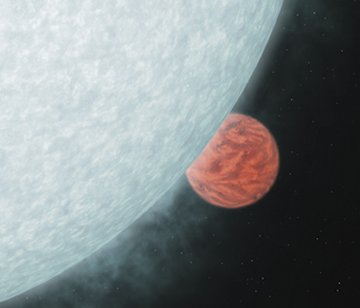Although astronomers have identified more than 130 planets beyond the solar system, these alien worlds remain phantoms. Too faint and small to be imaged, each planet has been detected only indirectly, either by the wobble it induces in its parent star or by the tiny amount of light it blocks when it passes in front of its star.

This week, two extrasolar planets stepped out of the shadows. Two teams of scientists announced at a NASA press briefing that they have for the first time directly detected the heat emitted from planets that circle sunlike stars more than 100 light-years from Earth.
“These are really epochal discoveries,” comments Alan Boss of the Carnegie Institution of Washington (D.C.) “We’re entering a new regime of planet detection.”
The observations don’t constitute images, but they provide information that enables astronomers to determine the temperatures of the extrasolar planets and the compositions of their atmospheres, notes David Charbonneau of the Harvard-Smithsonian Center for Astrophysics in Cambridge, Mass., who led one of the two studies.
Each team focused on a previously known planet. Both orbs are so-called hot Jupiters—planets about as heavy as Jupiter but much closer to a star’s blazing heat (see “Too Darn Hot,” in this week’s issue: Available to subscribers at Too Darn Hot). As viewed from Earth, each planet also passes in front of and behind its star.
Hot Jupiters glow brightest at infrared wavelengths. Using the infrared Spitzer Space Telescope, each team recorded the combined light of a planet and its star for the brief time the two were side by side, just before the planet dove behind its parent. Once the planet disappeared, the teams again used Spitzer to measure how much energy the star emitted on its own. The difference between the two measurements indicates how much heat comes from the planet.
Charbonneau and his colleagues, who will report their findings in the June 20 Astrophysical Journal, examined a planet called TrES-1, which lies about 450 light-years from Earth.
Charbonneau’s team found TrES-1 to have a scorching surface temperature of 1,060 kelvins. The planet glows more brightly at a wavelength of 8 micrometers than at 4.5 µm, an indication that its atmosphere is rich in carbon monoxide, Charbonneau says.
The other team, led by Drake Deming of NASA’s Goddard Space Flight Center in Greenbelt, Md., examined the planet HD 209458b, 150 light-years from Earth. In an upcoming Nature, the researchers report that the orb has a surface temperature of 1,130 K.
The study also highlights a planetary puzzle. HD 209458b is about 30 percent bigger than TrES-1, even though each planet has the same mass and orbits a similar star at a similar distance. The larger size of HD 209458b would make sense if it had a more elongated path, in which the gravity of the parent star would add extra heat to the planet, puffing it up.
But the timing of HD 209458b’s passage in front of and behind its star shows that the orbit is perfectly circular, Deming’s team notes.
Greg Laughlin of the University of California, Santa Cruz told Science News that his team’s recent measurements of the motion of the planet’s parent star provide even more compelling evidence for a circular orbit. The planet’s bloated appearance, he says, “is definitely quite a mystery.”







